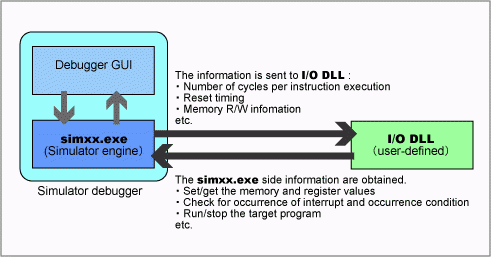Overview
Description
The I/O DLL kit provides a means for extending the functions of the simulator debugger in the High-performance Embedded Workshop integrated development environment (IDE). This kit supports the creation of I/O DLLs. The I/O DLL refers to a DLL (Note1) that operates in cooperation with the simulator engine of the simulator debugger.
Once the necessary settings are made, the simulator debugger allows you to load an I/O DLL and operate it synchronously with the timing at which instructions are single-stepped, memory is read or written or an interrupt occurs. That way, the operation of the input/output ports or the internal peripheral functions of the microcomputer can be simulated as a means of debugging the target program. Furthermore, linked operation with an external tool can be realized by, for example, sending and receiving data to and from that tool.
Any desired I/O DLL can be created by using C/C++ language. To create an I/O DLL, you need to have Microsoft Visual C++, a Windows application development environment available on the market.
Note
- DLL is the acronym of Dynamic Link Library. This is a function of the operating system that allows you to save executable routines (routines that supply a specific function or a set of functions) to be saved separately as a file with the extension ".dll". These routines are loaded only when they are needed by the calling program.
Target Devices
Support

Support Communities

Knowledge Base
Additional Details
Linkage Between the Simulator Engine and I/O DLL
The simulator engine calls the functions that have been predefined on the I/O DLL side synchronously with the timing shown below:
- After executing one instruction (number of execution cycles)
- Before execution (PC value)
- When the target is reset
- When an interrupt occurs
- Immediately before memory read (address information)
- Immediately after memory write (address information)
Conversely, the following functions that have been made public for the simulator engine can be called from the I/O DLL side:
- Get memory contents
- Set a memory value
- Get a register value
- Set a register value
- Interrupt occurrence
- Confirm interrupt occurrence condition
- Inspect the total number of cycles executed
Supported Simulator Debuggers
This I/O DLL kit is available for the following simulator debuggers in the compiler packages :
- Simulator Debugger for M16C Series and R8C Family
- Simulator Debugger for M32C Series
- Simulator Debugger for R32C Series
Note: This I/O DLL kit is NOT supported by the M3T-PDxxSIM simulator debuggers. For M3T-PDxxSIM, use the PDxxSIM I/O DLL Kit.
Development Tools Used
To create an I/O DLL, you need to have Microsoft Visual C++, a Windows application development environment available on the market.
Sample Programs
The following sample programs are stored in a location at the hierarchical level below the directory in which this I/O DLL kit is installed. Refer to the release note for details on how to install the I/O DLL kit.
- I/O DLL to link with Excel from Microsoft Corporation
- I/O DLL to read/write data from a file
- I/O DLL to simulate the operation of a microcomputer's internal peripheral functions

